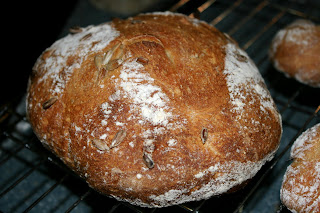 Today's blog is a little self-indulgent--that's what happens when one has too much time on one's hands.
Today's blog is a little self-indulgent--that's what happens when one has too much time on one's hands.I am patiently waiting for the phase of the moon to change so that I can plant more beets and transplant flowers, more broccoli seedlings, and sage cuttings. In my idle hours, I went to the grocery store and found these beautiful sunflowers marked down. Rambling around the yard, I picked a few things that were blooming, which included Spanish bluebells and vinca major, dogwood, azaleas, a Gerber daisy, and a rosebud.
After arranging them, I noticed I had paired the sunflowers with bluebells and vinca, and this reminded me of traveling to Provence in the south of France where sunflowers adorned linens and lavender bloomed profusely along the roads, especially going into the Luberon out of Apt. I smiled.
And I remembered what I tell my traveling friend Glenna: bring a little of France into your everyday life. So I did. I reveled in my flowers, and tonight I will enjoy a leisurely meal with my husband and a glass (or two) of good wine as I wait for the moon to cooperate with my itchy green thumb!
 For the other arrangement, I used the flowers I had enjoyed last week to fill my teapot. I use this teapot only in the spring for the azaleas and dogwoods, daffodils and Spanish bluebells. I waited too late for the daffodils. As I was arranging last week's sunflowers, the petals began to fall off. I ripped them off two of the flower heads and noticed something: They reminded me of Van Gogh's sunflowers. My memory may be poor, but I believe some of the flowers may have been painted without the yellow petals. Either way, they are beautiful.
For the other arrangement, I used the flowers I had enjoyed last week to fill my teapot. I use this teapot only in the spring for the azaleas and dogwoods, daffodils and Spanish bluebells. I waited too late for the daffodils. As I was arranging last week's sunflowers, the petals began to fall off. I ripped them off two of the flower heads and noticed something: They reminded me of Van Gogh's sunflowers. My memory may be poor, but I believe some of the flowers may have been painted without the yellow petals. Either way, they are beautiful.Well, this is a food blog, so I suppose I should end on a food note! In the garden, I have five potato plants sprouting leaves and two rows of beet seedlings have pushed their way through the soil. I've never grown either before, and I'm so excited to see them growing.
Leave me a comment. Tell me what you're doing to bring a special memory into your home. Or, maybe you're planting something new in the garden. I'd like to hear about it.
C'est tout!














